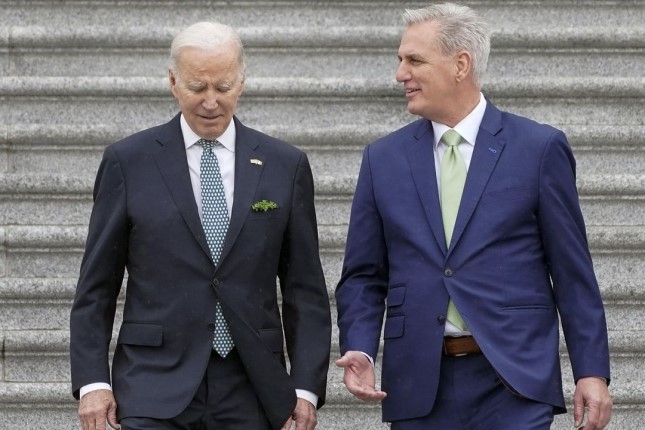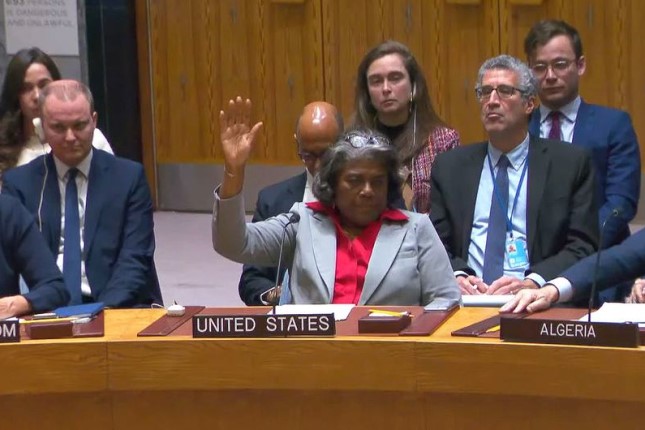After nearly three weeks of closed-door talks, Biden and McCarthy hailed an “agreement in principle” that is supposedly the necessary response to the danger of a “catastrophic” default on the national debt that would otherwise take place on June 5.
The entire crisis over an imminent debt default has a contrived and stage-managed character. This is underscored by the fact that over the past week, the US stock market has registered gains, with the Dow, the Nasdaq and the S&P 500 rising sharply on Friday, the price of gold falling, and the US dollar index registering its third straight weekly advance.
The agreement freezes discretionary spending for fiscal year 2024 at current 2023 levels and caps any increase for FY 2025 at 1 percent. It exempts spending for the military and veterans’ benefits. It affirms the 3 percent increase in arms spending proposed by Biden in March as part of a record military budget that will likely surpass $1 trillion, when tens of billions in outlays for the proxy war against Russia in Ukraine are included. On May 21, speaking after the G7 summit in Hiroshima at which he announced another $375 million in military aid to Kiev, Biden said his budget proposals in the debt talks would cut non-military discretionary spending by $1 trillion over the next decade.
Since the military is excluded from the spending caps, the impact on social programs will be heightened. Adjusted for inflation, the deal will mean a de facto cut to pre-2023 levels, one of the key demands of the Republicans.
The agreement claws back billions of dollars in unspent COVID relief funds, terminating aid to desperately underfunded education, health care, public transit, nutrition, housing and other social programs.
It shortens the review process for new drilling and energy projects, a boon to the fossil fuel industry.
It imposes new work requirements on Supplemental Nutrition Assistance Program (food stamp) recipients as well as those receiving Temporary Assistance to Needy Families (welfare) benefits. These cuts are deliberately cruel punishments targeting the poor and unemployed. They are nothing new for Biden, who voted for work requirements in the 1996 Clinton administration bill that abolished welfare as a federal entitlement program.
It is estimated that millions of people will lose their benefits as a result of the new work requirements. This comes on top of devastating cuts to Medicaid, the federal-state health insurance program for the poor, and food stamps resulting from Biden’s lifting of the national COVID emergency over the past two months. Hundreds of thousands of low-income people have already lost their Medicaid coverage since the COVID-linked ban on states removing people from their Medicaid rolls ended on April 1. The Kaiser Family Foundation estimates that up to 14 million people will eventually lose Medicaid coverage. These figures include millions of children.
Cuts in food stamp allotments resulting from the end of the official COVID emergency will impact more than 30 million people, according to the US Department of Agriculture. Describing the resulting “hunger cliff,” the Food Research & Action Center warned that people will on average lose $82 of SNAP benefits a month—this under conditions of double-digit food price inflation.
The bipartisan debt deal also excludes any increases in taxes on the wealthy. On the contrary, it rescinds billions of dollars previously allocated to hire more Internal Revenue Service agents to rein in rampant tax evasion by corporations and the rich.
In the flood of reporting and commentary on the debt crisis, nothing is said about the actual sources of the upward spiral of the US national debt. That is because they consist of massive increases in military spending, bank bailouts and tax cuts for corporations and the wealthy. Corporate profits have steadily risen over the past decade, while corporate tax revenues have fallen 60 percent, according to the US Bureau of Economic Analysis.
Meanwhile, spending on social programs has sharply declined since the Obama-Biden administration imposed a decade of spending caps following the 2008 Wall Street crash and the ensuing multi-trillion-dollar bailout of the financial parasites who caused the crisis.
It must be stressed that the cuts contained in the deal announced by Biden and McCarthy are not one-off measures. Rather, they mark an inflection point in the decades-long attack on the social conditions and living standards of the working class.
Interviewed on the “Fox News Sunday” program, McCarthy touted the deal as “changing the trajectory” of social policy and setting it on “a whole new direction.” While the agreement suspends the debt ceiling for two years—until after the 2024 elections—it includes a provision that automatically imposes an across-the-board 1 percent cut in non-military discretionary spending should Congress fail to pass all 12 federal appropriations bills (an annual occurrence) in any given budget year.
The deal is, moreover, a prelude to attacking the core entitlement programs—Social Security and Medicare—that remain from the social gains won in the class battles of the 1930s and 1960s. In two editorials published Sunday, the Washington Post drew the connection between the looming assault on these programs and the escalating war in Europe.
The first editorial hailed the debt ceiling deal, but cautioned that non-defense discretionary spending accounts for only 16 percent of government expenditures and “is not a key driver of the nation’s debt problems.” The Post continued: The refusal of either party to tackle rapidly rising Social Security, Medicare and health-care costs—along with Republicans’ opposition to any tax increases—means the debt limit isn’t forcing the tough choices that are needed.
The second Post editorial laid out the context of protracted and widening war that is driving the ruling class’ intensified assault on social programs. It stated: That means the burden is on the West to formulate plans for a long-term struggle. Arms supplies, procurement systems and defense budgets will need to reflect that commitment. Kyiv’s forces will need more cruise missiles from its Western allies, more ammunition, more air defense systems, more tanks, more armored vehicles.
The removal of Russia and China as obstacles to US global hegemony, by force of arms, has been the central concern of the Democratic Party since the Obama administration.
After Trump’s failed coup of January 6, 2021, Biden appealed for bipartisan unity with his Republican “colleagues,” most of whom had supported the coup, and called for a “strong” Republican Party. This was, and is, seen as necessary to maintaining sufficient internal political stability to pursue US imperialism’s war aims.
The “cordial” talks between Biden and Trump coup supporter McCarthy and the resulting agreement to step up the war on the working class are the inevitable outcome of the Democrats’ defense of the increasingly fascistic GOP. Whatever their differences, the two parties of Wall Street and the military agree on the need to crush the mounting resistance of the working class and impose mass poverty.
Photo: President Joe Biden and House Speaker Kevin McCarthy of California walk down the House steps Friday, March 17, 2023, on Capitol Hill in Washington © AP Photo / Mariam Zuhaib.
Source: World Socialist Web Site.
































